Creation Myths
|
by Stefan Stenudd |
Whether or not this is relevant, it has a ring of disrespect for the mind of man prior to the Scientific Revolution.
What the creation stories convey on the very surface are explanations to the emergence of the world. Yet, this is often the last thing considered in the study of them.
That's a grave mistake. Primordial man saw the sun rise and set, the seasons turn, and the birth and death of his fellow men. He must have wondered what it all meant, and how it all began. This reason for the emergence of creation myths deserves to be considered primarily.
Still, there is plenty of evidence in our history for the creation myths playing a significant role in the everyday life of societies of old. In many cases it's just as true today. These myths have been essential ingredients in rituals of worship and festivity, they have influenced the way of thought and principles of justice, and they have been integral parts of the foundations on which societies have been built and governed. They have also influenced the arts, language, and countless aspects of cultural heritage.
Therefore, it is quite likely that the creation myths have been altered through time in the dynamics of the societies where they were kept. Even if they were conceived as no more than speculations on the birth of the world and its creatures, their cultural roles and societal functions may very well have changed their content toward additional agreement with their functions. So, this too has to be considered.
Triangle of Functions
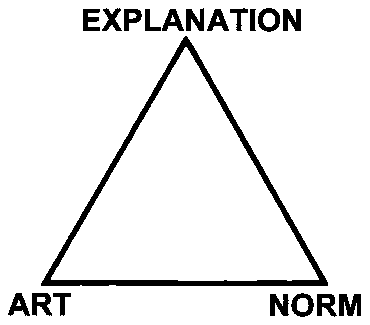
The triangle of functions in creation myths.
I see a triangle of functions of creation myths, where the three corners are explanation, norm, and art.
The explanation is the pre-scientific function of making some kind of sense about the world and its origin. The norm is the societal and moral function of establishing an order that the members of that society have to follow, whether it pleases them or not. It also contains the wish to find reason for and meaning to it all. The art is that diffuse function of satisfying the audience through an experience involving some kind of relief, in line with the Greek idea of catharsis.
All three corners of the triangle are likely to have been instrumental in the formation of any creation myth, as well as having influenced the alterations of it through time. Surely their influence has mostly been mixed, with differing dominance and dynamics between them over time.
Their tendencies are sometimes conflicting, and sometimes not. For example, the pure effort of explaining the world from experiences of it may not fit wishes of both order and meaning, especially when futility and decay seem to be the only things certain. So, the idea of an afterlife may have been the norm corner of the triangle balancing the experience of lives in hardship ending with no evident reward.
Artistic demands on creation myths have probably been present already at their forming, in order to make stories that would inspire the effort to pass them on through generations of oral transmission. Creation theories without an ounce of some kind of poetry were unlikely to be remembered by others than their inventors. Fantasy was surely allowed to add to what little was known from pure observation, and attractive images would have been kept even if they contradicted those observations in some way, though not too obviously.
The Relief of Tragedy
Aristotle in his Poetics did not demand that a drama should end morally, with the villain losing and the noble one victorious – although he expressed warnings against the very opposite, since that would not benefit a relieving catharsis for the audience, but just add to its frustration. The artistic corner of the triangle is indeed almost negligent of moral needs.
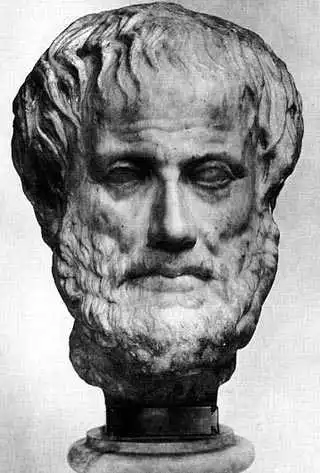
Aristotle (384-322 BC).
Sometimes a story containing and supporting a moral can be wonderfully attractive to an audience, but so can many stories that end bitterly for its most sympathetic characters. The dramas that Aristotle focused on were mostly tragedies, where just about everybody died miserably at the end. Equally sad is the story of Gilgamesh, the oldest one we have in written remains. Tragedy is rarely the stuff by which to make and support the norm corner of the triangle.
Yet, most tragedies have a moral ingredient. Not in such a way as to reward the noble at the end, but by showing somehow that their bad fate was the result of an ignorant mistake of theirs, like King Oedipus unknowingly marrying his mother and killing his father, or an anomaly in their environment, like the family feud forcing Romeo and Juliet to suicide.
In the latter case, the heroes were victims of things beyond their control, but thereby illuminating the problem for the audience and coming generations to recognize and correct. This is made very clear at the end of Romeo and Juliet, where Prince Escalus scolds the heads of the feuding families:
Where
be these enemies? Capulet, Montague,
See
what a scourge is laid upon your hate,
That
heaven finds means to kill your joys with love!
And
I, for winking at you, discords too,
Have
lost a brace of kinsmen. All are punish'd.
The families learn their lesson and make peace.
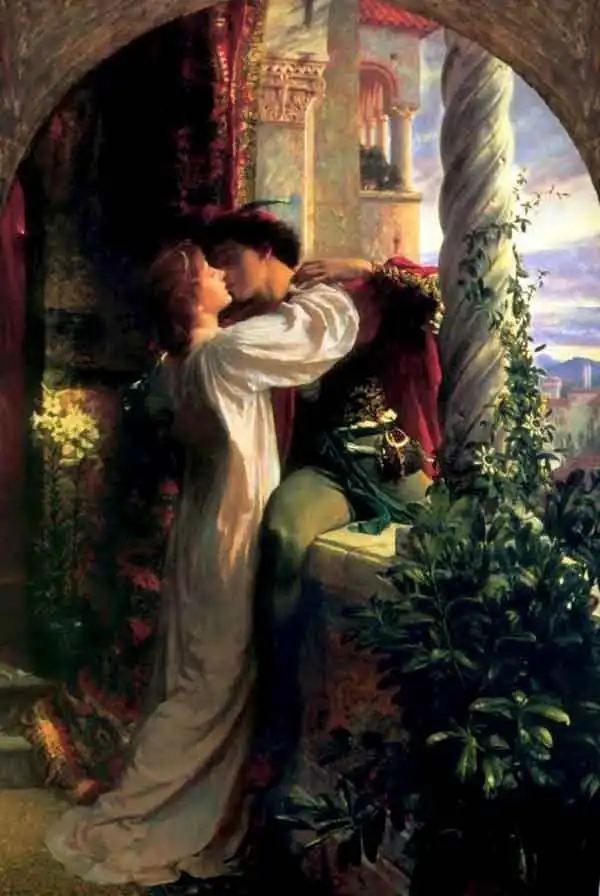
Romeo and Juliet. Painting by Frank Dicksee, 1884.
In any tragedy, there is some kind of lesson to be learned. Gilgamesh, for example, has to accept that it’s best to let the dead lie.
Such tragedies with a moral component are common in creation myths. The sad fate of Adam and Eve is another example. They are expelled from their carefree existence because they break the one rule of it, thereby firmly warning mankind never to make that mistake about any rule of divine origin, a great number of which are to follow in the succeeding books of the Bible.
These dramatic ingredients of creation myths may have been present from the start, or they were added later in order to satisfy the needs of this corner of the triangle.
Homo Rudis
We can’t establish much about the mind of man before the dawn of civilization. Nor can we be sure that primordial man was the originator of the creation myths or even their embryos. But we must try to understand him, if we are to study what might be expressions of his thinking.As long ago as about two millions years, the human mind started growing significantly. One million years ago it had a size very near the present (circa 1200 cc, compared to the modern average of 1400 cc). That big brain must have had something to do.
In order to investigate the mind of primordial man, I sketch a brain very similar to ours in resources and complexity, but in an environment without scientific knowledge – and with no means of transmitting discoveries and theories of any intricacy from one generation to the next. I call this model of primordial man Homo rudis, the unlearned man.
It can also be translated as primitive man, but I dislike this expression, often used in 19th and early 20th century anthropology, because it assumes a lack of mental ability in our distant forefathers, which is not necessarily the case. It has also been used for hunter and gatherer societies in our present world, which is even worse. When studied closely, they prove to be anything but primitive.
So, Homo rudis is man before the emergence of science and its explanations of natural phenomena. He had a brain much like ours, but very little knowledge to absorb into it. He had to make his conclusions about nature and existence from his own observations, with little means of empirical study or the fountain of experiences from many previous generations that we have at our disposal. What he saw was what he knew, and that was it.
The creation myths that remain in our records should be considered from the perspective of Homo rudis, so that we can comprehend the environment and circumstances in which they were conceived.
Of course, far from all creation myths are inventions of Homo rudis, but of later origin. They may still carry fragments of earlier versions, maybe as far back as to the days of Homo rudis. Only if these fragments hold dominant positions in the myth, or if they distort its plot in a way that makes the myth somewhat incomprehensible, will it be necessary to extract them by considering the Homo rudis perspective.
There is no rock solid way of confirming that we must go back to the time of Homo rudis to find the emergence of a creation myth, but it's rather easy to establish what myths or portions thereof would have made sense to Homo rudis. That's an indication of those myths actually being that old.
I suspect that a lot of the creation myths preserved have such a distant origin – at least some major fragments of them.
Present Day Tribes
It may be tempting to go to present day hunter and gatherer tribes in search for minds like that of Homo rudis, especially if they have been isolated from our society’s influences. But that's a complete mistake.Their societies have been around just as long as ours. There is no way of knowing how much their thoughts and ideas have progressed from the primordial stage of Homo rudis. Close investigations of their myths and beliefs show a complexity and level of abstraction that suggests additions and modifications through many generations of transmittance.
To what extent this complexity is a late addition or was present already at the time of Homo rudis, is usually quite impossible to establish with any certainty. The risk of mistakes on this issue makes it important not to assume that the mind of Homo rudis is to be found among people living today.
We should not apply the Homo rudis perspective to myths that are alive today, although some ingredients make it tempting, except for the purpose of trying to extract their oldest components. But on myths retrieved from our distant past, the mind of Homo rudis can be a rewarding way of trying their age and the thoughts behind them.
Next
- Introduction
- Man, Too
- Human Thought Revealed
- Trusting Creation Myths
- Time and Place
- Authenticity
- Inner Story Logics
- Function
- Triangle of Functions
- The Relief of Tragedy
- Homo Rudis
- Present Day Tribes
- Belief
- Doubt
- The Evolution of Creation Myths
- Subconscious Creation
- Simplicity and Urgency
- The All Was Born in the Past
- Originality
- Religion, Science, or Art
- What Can Be Reached
This text was written as an introduction of sorts to my ongoing dissertation on creation myths, at the Lund University History of Ideas and Learning.
Some of My Books:Click the image to see the book at Amazon (paid link).
The Greek philosophers and what they thought about cosmology, myth, and the gods. |
MENU
Creation Myths Around the World
How stories of the beginning began.
The Meanings of Mythology
Theories through history about myth and fable.
Archetypes in Myths
The mythological symbols and what they stand for.
The Logics of Myth
Patterns of creation.
CREATION MYTHS IN DEPTH
Creation in Rig Veda 10:129
The paradox of origin, according to an Indian myth.
Genesis 1
The first creation story of the bible scrutinized.
Enuma Elish
The ancient Babylonian creation myth.
Xingu Creation of Man
The insoluble solitude of gods and humans.
Contact
About Cookies
ON MY OTHER WEBSITES
Psychoanalysis of Myth
What Sigmund Freud and C. G. Jung thought about myths, their origins and meanings.
Myth of Creation
An introduction to the subject of creation myths and the patterns of thought they reveal.
Cosmos of the Ancients
What the Greek philosophers believed about the cosmos, their religion and their gods.
Life Energy
The many ancient and modern life force beliefs all over the world explained and compared.
Taoistic
Taoism, the ancient Chinese philosophy of life explained. Also, the complete classic text Tao Te Ching online.
 Stefan Stenudd
Stefan Stenudd
About me
I'm a Swedish author and historian of ideas, researching the thought patterns in creation myths. I've also written books about Taoism, the Tarot, and life force concepts around the world. Click the image to get to my personal website.
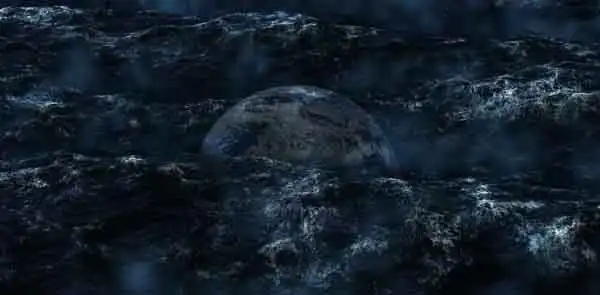
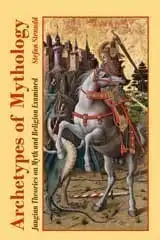 Archetypes of Mythology
Archetypes of Mythology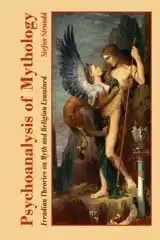 Psychoanalysis of Mythology
Psychoanalysis of Mythology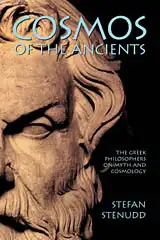 Cosmos of the Ancients
Cosmos of the Ancients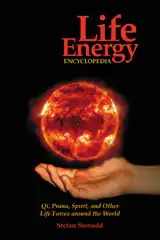 Life Energy Encyclopedia
Life Energy Encyclopedia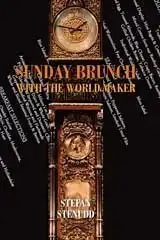 Sunday Brunch with the World Maker
Sunday Brunch with the World Maker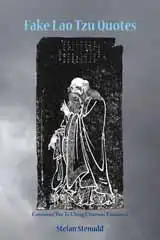 Fake Lao Tzu Quotes
Fake Lao Tzu Quotes